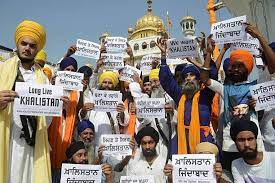“The draconian and tyrannical response of the Indian state to Sikh advocacy ever since [the 1984 Sikh Genocide] has made it clear – openly talk about Sikh sovereignty at your peril.”
By Jasveer Singh
This week, an article written by three non-Sikhs in India was published in The New York Times with the headline “Sikh Separatism Is a Non Issue in India, Except as a Political Boogeyman.” It leaned on a common claim that only Sikhs in the diaspora care about, or want, Khalistan.
Is this true, though? No.
These articles or opinions are often written by individuals with little insight into the Sikh community or historical realities.
Before exploring why the Khalistan issue is not a “nonissue” in India and how the Indian state has attacked Sikhs and chilled public advocacy around Khalistan, we need to establish a historical context. Context which articles like that found in The New York Times either ignore or gloss over.
Commentators overlook the 1986 Sarbat Khalsa, which saw hundreds of thousands of Sikhs come together in Amritsar as the Sikh Genocide raged.
The Sarbat Khalsa is an authentic Sikh political mechanism for decision-making. The process is as rare as it is sacrosanct, with decisions expected to be upheld until a Sarbat Khalsa says otherwise. A decree to pursue the goal of Khalistan was discussed and accepted by countless community leaders in 1986, representing an expansive range of Sikh groups. Decades later, no major Sikh group has ever come out to say they no longer believe in the 1986 Sarbat Khalsa decree, to the media or anywhere else. This is because the pursuit of Khalistan is still seen as part of Panthic, or Sikh community, goals.
Staying within this period, one of the most revealing features of the “no one in India supports Khalistan” narrative is the omission of the impact of the Sikh Genocide itself. The draconian and tyrannical response of the Indian state to Sikh advocacy ever since has made it clear – openly talk about Sikh sovereignty at your peril.
Is it surprising, then, that three non-Sikh Indian journalists had trouble finding Sikhs who would openly talk in support of Khalistan in Punjab?
Starting at least from 1984, the Indian state attacked Sikh institutions, culture, and Gurdwaras, as well as extrajudicially murdered or disappeared an untold amount of Sikhs through brutal state terror. This has been partly documented in part by the late Shaheed Jaswant Singh Khalra and more recently by USA-based Ensaaf and UK-India-based Punjab Disappeared. The recent sentencing of just some of the perpetrators of these massacres has affirmed that even children were not spared.
Has this type of targeting ended? No. While tactics and the scale of violence may have shifted in some aspects, the targeting continues to this day.
The draconian operation against Bhai Amritpal Singh earlier this year, which saw widely condemned suspension of civil liberties and democratic rights in Punjab to capture popular pro-Khalistan Sikh advocates who had not committed any real crime, is just a recent example. More on that later.

Punjab Police use of “Khalistan deradicalization cells” saw countless locked up in recent years just to force Sikhs away from self-determination movements. One officer is even quoted as saying about one detainee in 2020, “he is not involved in any crime.”
In another clear example of the lengths the Indian state still goes to silence Sikh voices, in 2019, three Sikhs were given life in prison for the mere possession of pro-Sikh sovereignty literature and liking Facebook posts about Khalistan. That’s it.
No weapons or violence, including plans for violence, were cited as evidence. Only literature and social media activity was deemed enough for life sentences, which international UK-based aid group Sikh Relief is still challenging to this day.
This criminalization of Sikh dissent has been well documented as central to how India stifles Khalistan support.
The idea that random journalists could get any real insight into support for Khalistan amid these conditions is laughable.
When it suits Indian media, which is ranked 161 out of 180 countries in press freedom rankings, support for Khalistan amongst India’s Sikhs will be readily publicized to attack the community, as evidenced, for example, during the Farmers’ Protest. Then, when it suits a different agenda, suddenly, Khalistan support is non-existent in India and only a diaspora agenda.
Nevertheless, support for Khalistan in India cannot be hidden or denied.
The funeral of actor-turned-activist Deep Sidhu was a massive communal gathering last year. Sidhu died in a suspicious car accident after becoming a globally popular figure for his support of the Farmers’ Protest movement and, within that, support for Sikh sovereignty. At his funeral, support for Khalistan was prominent among an estimated 100,000 plus attendees.
Similarly, Punjab’s outpouring for music star Sidhu Moose Wala, most evident after his assassination last year, is entwined with support for Sikh sovereignty, as the artist’s popularity partly stemmed from his poetic way of glorifying Sikh resistance, along with his public advocation for ideas of Khalistan.
The plight of Bhai Amritpal Singh, as referenced earlier, is also another example of both prominent support for Khalistan and the Indian State’s urgency to crush it.

For approximately two years, Bhai Amritpal Singh was a massively popular figure for his efforts to challenge Punjab’s drug epidemic, which involved advocacy for Khalistan too. Thousands would come and see him as he toured across Punjab, promoting Sikh ideas of sovereignty in the face of Punjab’s current corrupt system. Predictably, this led to his arrest and imprisonment in April this year as part of a large operation including thousands of police officers and central government involvement.
Only three months ago, Punjab-based Sikh organization Dal Khalsa led marches of thousands in support of Khalistan, as covered by BBC Punjab. Such acts are carried out despite attendees knowing they are making themselves possible targets for police harassment.
If all of this is not enough affirmation of Khalistan support in India, in 2020, Giani Harpreet Singh, the then head of the Akal Takht, the Sikh centre of temporal authority, said in a press conference, “all Sikhs want Khalistan,” which was seen as acknowledgement towards Khalistan support becoming more vocalized in India – even by non-Sikhs – around the Farmers’ Protest period.
Many will ask, why is this support not reflected in votes? Why has the pro-Khalistan Shiromani Akali Dal (Amritsar) (SAD(A)) party not seen wide success during Punjab’s elections?
On this, the first thing to note is that Punjabis recognize voting for SAD(A) will not guarantee a sovereign Punjab. It will, however, expose pro-Khalistan sentiment, which has previously led to a heavy-handed response from the Indian government. This is not like Canada, where a Quebec separatist party and its supporters can operate freely without consequence, for example.

Secondly, the complexity of Punjab politics, and India for that matter, cannot be seen via a two-dimensional lens. “Who can get our work done?” is the typical calculus in a country known for political and state corruption.
Having said that, in June 2022, Simranjit Singh Mann, leader of the pro-Khalistan SAD(A), won a federal by-election in sitting Punjab Chief Minister Bhagwant Mann’s old seat. A clear message that Khalistan is not a non-issue in Punjab, even when politics is considered.
While it must be acknowledged some Sikh groups are not in favour of the current Khalistan movement, every Sikh body – literally every single one – believes in the concept of Khalsa Raj, or Sikh rule, which is advocated in the daily official Sikh prayer.
Ultimately, any attendee to pro-Khalistan events from Brampton to Birmingham, San Francisco to Sydney, will notice that arguably the largest section of support comes from recent Punjab migrants. Organizations like Sikhs For Justice, the North American Sikh Alliance and Kesri Lehar are examples of this.
Why is that?
Western freedoms allow Sikhs, previously restrained in India, to support the Khalistan movement openly.

















7 Comments
eco blankets
12 months agoHey there! Do you know if they make any plugins to help with Search Engine Optimization? I’m trying to get my website to rank for some targeted keywords but I’m not seeing very good results.
If you know of any please share. Appreciate it!
I saw similar art here: Bij nl
www.binance.com рестраця
8 months agoThanks for sharing. I read many of your blog posts, cool, your blog is very good.
Beau
7 months agoI am really inspired with your writing abilities and also with the format for your weblog. Is this a paid theme or did you modify it yourself? Either way keep up the excellent high quality writing, it is rare to see a great weblog like this one today. I like desibuzzbc.com ! Mine is: TikTok ManyChat
Emmanuel
7 months agoI’m really inspired together with your writing abilities and also with the format on your blog. Is that this a paid theme or did you modify it yourself? Anyway stay up the nice quality writing, it is rare to see a nice weblog like this one these days. I like desibuzzbc.com ! I made: Stan Store
Morris Baylis
3 months agoUsually I don’t learn post on blogs, however I wish to say that this write-up very forced me to take a look at and do so! Your writing style has been amazed me. Thanks, very nice article.
togel online terpercaya
2 months agoRegards for this terrific post, I am glad I detected this site on yahoo.
idn poker apk
2 months agoMerely wanna comment that you have a very nice internet site, I love the style and design it really stands out.